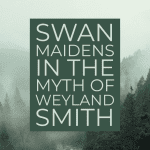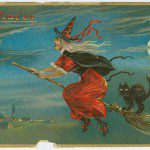Birds and Stars in the Lore
Birds are often connected to transformation, the Otherworlds, and death. In the Lithuanian tradition the souls of the dead are said to turn into birds and fly along the milky way, which they call Paukščių Takas, The Way of Birds, or Vėlių Kelias, The Way of Souls. The Estonians called it Linnutee, The Bird Way, and the souls are said to be lead by a white bird with the head of a woman and the souls she leads take the form of a goose, duck, diver, or bluebird.

Birds and Stars Rediscovered
Songbird Migration is Weirder and Cooler than I Ever Imagined
A lot of birds migrate, including a number of species of large waterbird, which is why I got interested in the first place. However, most of the research has been done on smaller songbirds, which makes a lot of sense, it’s much harder to catch large and sometimes unwilling birds that can break your arm if they try. So in trying to understand swan migration I’ve discovered a lot of interesting info about songbird migrations I’ve decided to share with all of you.
Songbirds have unique nighttime migration calls. The atmosphere at night is more stable, and that is part of why night migration is better. Songbirds don’t just fly off any old tree in any old way. They launch themselves into the air about a half hour after sunset by flying straight up! Then they face into the headwind, which launches them even higher to their cruising altitude. While they usually fly about 3 to 5 hours per night, if they are crossing an inhospitable stretch, like a large body of water they can fly for up to 80 hours at a time.
Before migration songbirds can double their body mass in a week. Spring migration is faster because of the mating pressures. It’s a race. Fall migration is the first migration for the new hatchlings, which also may be why it takes longer. Hatchlings are born knowing where they need to go using inherent navigation techniques that use magnetic fields, the sun, and the stars.

Birds Have Star Guidance Systems Built into Their Hardware
Steve Emlen studied songbirds in the ‘60’s using an apparatus called the Emlen funnel. Originally people thought birds memorized the star map, but that would be quite a feat, considering that stars rotate throughout the night. They’d need to be able to correct for the time and season.
Scientists actually discovered what was happening at the Robert Longway Planetarium in Flint Michigan. They put first year blue buntings in Emlen funnels, which are these odd little cages that had ink pads on the bottom and paper around the wide funnel shaped walls, with wire mesh covering the top so the birds could see the ceiling of the planetarium. When the birds flew, they would leave little tell-tale footprints that recorded which direction they landed in. There were three different conditions for the planetarium itself. In the first, the “sky” was left dark and blank. There were no stars. In the second condition the “sky” appeared as it normally does during migration season. In the third condition the north star got stole and swapped, instead of having the stars swirl around Polaris, found in the little dipper, the stars circled Betelgeuse in the constellation Orion. The results were clear. In the first condition, with no stars, the birds hopped randomly. In the second and third they followed the pole star, no matter if it was Polaris or Betelgeuse. This means that birds don’t memorize a map, they just look for the center of the stellar rotation.
Thousands of years ago, Vega was the central star and 12,000 years from now it will be again. Lucky for the birds, these vagaries of earthly rotation and tilt won’t affect their migration patterns. Considering that bird species have been around for 60 million years, 12,000 years is a mere drop in the bucket for their navigational systems.
Birds Use Magnetic Fields to Navigate Too
Birds also use magnetic inclination to navigate. That’s a fancy way of saying they use the angle of the magnetic field compared to the earth. We know that the earth’s magnetic field is not circular like the earth itself. Really, it kind of looks like a fourth dimensional n-sphere, just like all magnetic fields do, with poles sticking out the top and bottom, and a sort of smoosh between a donut and a sphere in-between. New research shows that birds use a special eye receptor to see these fields and are able to tell the difference between the steep angle of polar magnetic fields and the more parallel fields of the equator compared to the surface of the earth. So essentially the magnetic field can tell them the directionality of pole or equator.
Modern city lights do cause problems for migration, but cities such as Chicago have been working to redesign their lights so that they don’t effect the birds navigational systems. It’s like the Federal Aviation Administration for birds. Climate change is also affecting timing, and has caused reverse migration where birds find that they’ve moved to their northern breeding grounds too soon for food sources to have developed. Tracking birds has shown they will fly southward in order to find food, but this depletes their resources dangerously and makes breeding more difficult. Birds do seem to be able to adjust to the destabilization of the magnetic poles fairly easily, so there’s a win.
Bringing it Back Around
So far the research on these onboard navigational systems has centered on the smaller migrational birds, various species of songbirds. It was shown that migrators have far more of the ocular receptors for magnetic fields than chickens, a species that has never migrated. We don’t know yet if larger migrating birds such as cranes or swans also have magnetic and stellar senses, but it would make sense that they could, considering that even chickens have some residual receptors. Only time and more research will tell.
As a modern pagan, I conceptualize the darkness of the underworld and the darkness of the night sky to be connected. When we honor the ancestors and the passing of our loved ones, we can call on the spirits to guide them along the bird’s road to their new home. In the spring and fall we can remember that our bird cousins are migrating, just as the Sidhe are said to do. Zugunruhe is a German word for the restlessness of caged birds that came from that early Victorian research. That stir crazy feeling of needing to get out of the house and needing to move can be our own connection to their migrations as well.
I do bird divination by watching for the First Robin of spring, one of the many migratory birds that come back to Michigan for their breeding season. Whatever I am doing when I spot the first robin is my omen for the year. This year I was walking with my children. It was a good omen.
May the birds bring you good omens and guide your ancestors home.
Sources:
http://www.lithuanian.net/mitai/cosmos/baltai5.htm
http://www.folklore.ee/folklore/vol22/milkyway.pdf
http://www.lablit.com/article/341
Lecture by Dr. Jen Owen of Michigan State University on Bird Migration and Stars
If you find my work useful please consider supporting my habit of hiding out in coffee shops reading pdfs of obscure archeology articles.












